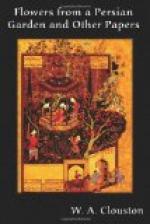Various amusements made the afternoon pass very agreeably to the stranger, until supper-time, when a fine capon was placed upon the table, which the master desired his guest to carve for the company. The young man took the capon, and began to carve and distribute it thus: To the master of the house he gave the head; to the mistress, the inward part; to the two daughters, each a wing; to the two sons, each a leg; and the remainder he took for himself. After supper the master of the house thus addressed his visitor: “Friend, I thought thy carving at dinner somewhat peculiar, but thy distribution of the capon this evening seems to me extremely whimsical. Give me leave to ask, do the citizens of Jerusalem usually carve their capons in this fashion?”
“Master,” said the youth, “I will gladly explain my system of carving, which does appear to you so strange. At dinner I was requested to divide five chickens among seven persons. This I could not do otherwise than arithmetically; therefore, I adopted the perfect number three as my guide—thou, thy wife, and one chicken made three; thy two daughters and one chicken made three; thy two sons and one chicken made three; and I had to take the remaining chickens for my own share, as two chickens and myself made three.” “Very ingenious, I must confess,” said the master. “But how dost thou explain thy carving of the capon?” “That, master, I performed according to what appeared to me the fitness of things. I gave the head of the capon to thee, because thou art the head of this house; I gave the inward part to the mistress, as typical of her fruitfulness; thy daughters are both of marriageable years, and, as it is natural to wish them well settled in life, I gave each of them a wing, to indicate that they should soon fly abroad; thy two sons are the pillars of thy house, and to them I gave the legs, which are the supporters of the animal; while to myself I took that part of the capon which most resembles a boat, in which I came hither, and in which I intend to return.” From these proofs of his ingenuity the master was now fully convinced that the stranger was the true son of his late friend the merchant, and next morning he delivered to him his father’s property.[85]
[85] The droll incident of dividing
the capon, besides being
found
in Sacchetti, forms part of a popular story
current
in Sicily, and is thus related in Professor
Crane’s
Italian Popular Tales, p. 311 ff., taken from
Prof.
Comparetti’s Fiabe, Novelle, e Racconti
(Palermo,
1875), No. 43, “La Ragazza astuta”:
Once upon
a
time there was a huntsman who had a wife and two
children,
a son and a daughter; and all lived together
in
a wood where no one ever came, and so they knew
nothing
about the world. The father alone sometimes went
to
the city, and brought back the news. The king’s




